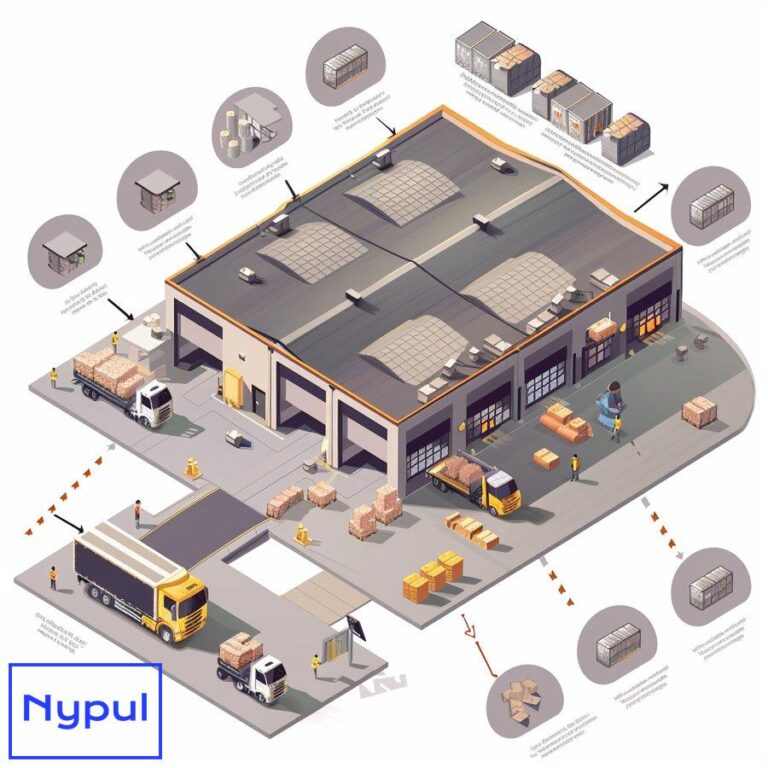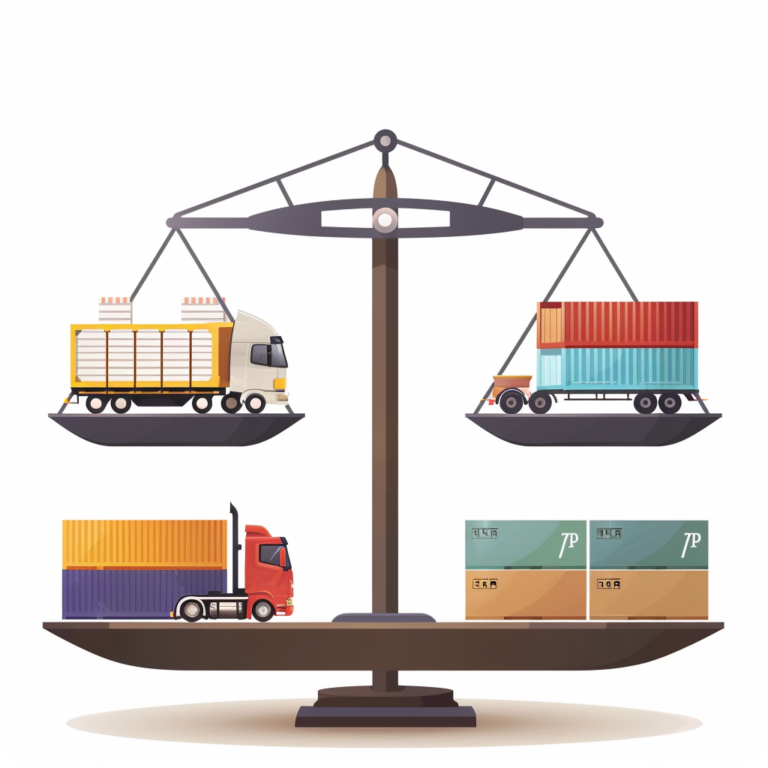Is Turnaround Time a KPI
What is turnaround time in logistics and drayage?
Turnaround time in logistics and drayage refers to the total duration required to complete a specific operation or process within the supply chain. This critical metric encompasses the time from when a task begins until it is fully completed and ready for the next stage. In the context of drayage, turnaround time often focuses on the period between a truck’s arrival at a port or terminal and its departure with a loaded container.
The concept of turnaround time is fundamental to understanding efficiency in logistics operations. It serves as a key indicator of how quickly and smoothly goods move through various stages of transportation and handling. For drayage providers, shippers, and port operators, minimizing turnaround time is crucial for optimizing resource utilization and maintaining a competitive edge in the industry.

Components of Turnaround Time
Truck Arrival: The moment a truck enters the port or terminal premises.
Documentation Processing: Time spent on paperwork, customs clearance, and other administrative tasks.
Container Pickup: Duration required to locate and retrieve the designated container.
Loading/Unloading: Time taken to load or unload cargo from the truck.
Equipment Inspection: Period allocated for checking the condition of containers and trucks.
Exit Procedures: Time needed to complete final checks and exit the facility.
Each of these components contributes to the overall turnaround time, and inefficiencies in any area can lead to delays and increased costs. Logistics professionals must understand these elements to identify bottlenecks and implement improvements effectively.
Significance in Modern Supply Chains
Turnaround time has gained increased importance in today’s fast-paced, globalized economy. With the rise of e-commerce and just-in-time inventory management, businesses face mounting pressure to deliver goods quickly and reliably. Efficient turnaround times enable:
Faster Order Fulfillment: Reduced waiting periods at ports and terminals translate to quicker delivery to end customers.
Cost Reduction: Minimizing idle time for trucks and drivers leads to lower operational costs.
Improved Asset Utilization: Faster turnarounds allow for more trips and better use of available resources.
Enhanced Customer Satisfaction: Timely deliveries contribute to positive customer experiences and loyalty.
Competitive Advantage: Companies that consistently achieve rapid turnarounds can differentiate themselves in the market.
Factors Influencing Turnaround Time
Port Infrastructure: The layout, equipment, and technology available at ports significantly impact efficiency.
Labor Productivity: Well-trained and motivated staff can expedite various processes.
Traffic Conditions: Congestion within and around port areas can cause delays.
Weather: Adverse weather conditions may slow down or halt operations.
Regulatory Environment: Customs procedures and documentation requirements can affect processing times.
Technology Integration: Advanced systems for tracking, scheduling, and communication can streamline operations.
Understanding these factors is crucial for logistics managers and drayage operators seeking to optimize their turnaround times. By addressing each aspect systematically, companies can work towards achieving faster, more reliable service.
Turnaround Time vs. Other Logistics Metrics
While turnaround time is a crucial metric, it’s essential to understand its relationship with other key performance indicators in logistics:
| Metric | Definition | Relationship to Turnaround Time |
|---|---|---|
| Transit Time | Duration of goods in transit | Turnaround time impacts overall transit time |
| Dwell Time | Time cargo spends at a facility | Often included within turnaround time calculations |
| On-Time Delivery | Percentage of shipments delivered as scheduled | Influenced by efficient turnaround times |
| Throughput | Volume of goods processed in a given time | Faster turnarounds can increase throughput |
| Demurrage Charges | Fees for extended use of containers | Reduced by minimizing turnaround time |
This table illustrates how turnaround time interacts with and influences other important logistics metrics. Optimizing turnaround time can have a cascading positive effect on various aspects of supply chain performance.
In conclusion, turnaround time is a fundamental concept in logistics and drayage that measures operational efficiency. It encompasses multiple stages of the cargo handling process and is influenced by various internal and external factors. As businesses continue to seek ways to streamline their supply chains, understanding and improving turnaround time remains a top priority for logistics professionals worldwide.
How does turnaround time qualify as a KPI?

Turnaround time qualifies as a Key Performance Indicator (KPI) in logistics and drayage due to its direct impact on operational efficiency, cost-effectiveness, and customer satisfaction. This metric provides valuable insights into the overall performance of a company’s logistics operations and serves as a benchmark for continuous improvement.
Alignment with Strategic Goals
Turnaround time as a KPI aligns closely with the strategic objectives of logistics and drayage companies:
Operational Efficiency: Faster turnaround times indicate streamlined processes and effective resource utilization.
Cost Reduction: Minimizing idle time for trucks and equipment translates to lower operational costs.
Customer Satisfaction: Quick turnarounds enable faster deliveries, meeting or exceeding customer expectations.
Competitive Advantage: Companies with consistently low turnaround times can differentiate themselves in the market.
Measurability and Quantifiability
A key characteristic of any effective KPI is its ability to be measured and quantified. Turnaround time meets this criterion:
Precise Measurement: Turnaround time can be accurately measured in hours or minutes.
Data Collection: Modern logistics systems allow for automated tracking and recording of turnaround times.
Comparative Analysis: Historical data enables companies to track improvements over time and benchmark against industry standards.
Actionable Insights
Turnaround time as a KPI provides actionable information that can drive decision-making and process improvements:
Bottleneck Identification: Analyzing turnaround time data helps pinpoint areas of inefficiency in the logistics chain.
Resource Allocation: Understanding turnaround patterns allows for better staff and equipment scheduling.
Process Optimization: Continuous monitoring of turnaround times facilitates targeted improvements in specific operational areas.
Impact on Other KPIs
Turnaround time influences and interacts with several other important KPIs in logistics:
| Related KPI | Relationship to Turnaround Time |
|---|---|
| On-Time Delivery Rate | Faster turnarounds contribute to improved on-time delivery performance |
| Asset Utilization | Efficient turnarounds lead to better utilization of trucks and equipment |
| Cost per Unit | Reduced idle time lowers operational costs, impacting the cost per unit shipped |
| Customer Satisfaction Score | Quicker deliveries resulting from fast turnarounds can boost customer satisfaction |
| Throughput | Faster turnarounds enable higher volume processing at terminals and warehouses |
This table demonstrates how turnaround time as a KPI has a ripple effect on various aspects of logistics performance, underlining its importance as a core metric.
Relevance Across the Supply Chain
Turnaround time’s relevance extends beyond a single point in the supply chain:
Ports and Terminals: Measures efficiency of loading/unloading operations and documentation processes.
Drayage Providers: Indicates how quickly trucks can complete pickups and deliveries.
Warehouses: Reflects the speed of receiving, processing, and dispatching goods.
Shippers: Provides insights into the overall efficiency of their chosen logistics partners.
This wide-ranging applicability makes turnaround time a versatile KPI that can be used to assess performance at multiple levels of the logistics network.
Responsiveness to Improvement Efforts
A valuable KPI should be responsive to improvement initiatives, and turnaround time fits this criterion:
Process Reengineering: Changes in operational procedures can lead to immediate improvements in turnaround times.
Technology Implementation: Adoption of new technologies, such as automated gate systems or digital documentation, can significantly reduce turnaround times.
Training and Development: Investing in staff training often results in noticeable enhancements in turnaround efficiency.
This responsiveness allows companies to see tangible results from their improvement efforts, reinforcing the value of focusing on this KPI.
Balancing Act with Other Metrics
While turnaround time is a crucial KPI, it’s important to consider it in conjunction with other metrics to ensure a balanced approach to performance management:
Quality Assurance: Efforts to reduce turnaround time should not compromise the quality of service or safety standards.
Cost Considerations: Investments in reducing turnaround time need to be balanced against the potential financial benefits.
Environmental Impact: Faster turnarounds should be achieved without increasing the carbon footprint of operations.
By considering turnaround time alongside these factors, companies can ensure that improvements in this KPI contribute to overall business success without negative consequences in other areas.
Industry Recognition
The logistics and drayage industry widely recognizes turnaround time as a standard KPI:
Benchmarking: Industry associations and consultancies often use turnaround time as a key metric in performance benchmarking studies.
Contract Negotiations: Many service level agreements (SLAs) between logistics providers and their clients include turnaround time targets.
Performance Reports: Turnaround time frequently features in internal and external performance reports of logistics companies.
This widespread acceptance further solidifies turnaround time’s status as a legitimate and valuable KPI in the industry.
In conclusion, turnaround time qualifies as a KPI due to its alignment with strategic goals, measurability, ability to provide actionable insights, and wide-ranging impact on logistics operations. Its influence on other key metrics, relevance across the supply chain, and responsiveness to improvement efforts make it an indispensable tool for performance management in logistics and drayage. As the industry continues to evolve, turnaround time remains a critical indicator of operational excellence and a driver of competitive advantage.
What are the different types of turnaround time in the industry?
The logistics and drayage industry recognizes several types of turnaround time, each focusing on specific aspects of the supply chain. Understanding these variations is crucial for comprehensive performance management and targeted improvement efforts.
Port Turnaround Time
Definition: The duration a vessel spends at a port, from arrival to departure.
Key Components:
– Berthing time
– Cargo handling time
– Documentation processing
– Customs clearance
Significance: Port turnaround time is critical for shipping lines and port operators, as it directly impacts vessel scheduling and port capacity utilization.
Terminal Turnaround Time
Definition: The time taken for a truck to enter a terminal, complete its transaction (pickup or drop-off), and exit.
Key Components:
– Gate-in processing
– Container location and retrieval
– Loading/unloading
– Equipment inspection
– Gate-out processing
Significance: This metric is crucial for drayage operators and terminal managers, as it affects daily truck productivity and terminal congestion levels.
Warehouse Turnaround Time
Definition: The duration required to process incoming or outgoing shipments at a warehouse facility.
Key Components:
– Truck check-in
– Unloading/loading of goods
– Inventory management updates
– Quality checks
– Paperwork completion
Significance: Warehouse turnaround time impacts inventory management, labor scheduling, and overall supply chain velocity.
Intermodal Turnaround Time
Definition: The time taken to transfer cargo between different modes of transportation (e.g., from ship to rail or truck to air).
Key Components:
– Unloading from initial mode
– Temporary storage or direct transfer
– Loading onto subsequent mode
– Documentation updates
Significance: Efficient intermodal turnaround times are essential for seamless multi-modal transportation and minimizing total transit time.
Equipment Turnaround Time
Definition: The period between when a piece of equipment (e.g., container, chassis) is returned and when it’s ready for the next use.
Key Components:
– Inspection
– Cleaning
– Repairs (if necessary)
– Repositioning
Significance: Quick equipment turnaround ensures optimal asset utilization and availability for subsequent shipments.
Customs Clearance Turnaround Time
Definition: The time required for goods to clear customs procedures at borders or ports.
Key Components:
– Document submission
– Inspection scheduling
– Physical examination (if required)
– Duty payment
– Release approval
Significance: Customs turnaround time affects overall shipment lead times and can be a significant factor in international trade efficiency.
Cross-Docking Turnaround Time
Definition: The duration between receiving goods and dispatching them without long-term storage, typically in less than 24 hours.
Key Components:
– Inbound truck unloading
– Sorting and consolidation
– Outbound truck loading
– Documentation updates
Significance: Cross-docking turnaround time is crucial for time-sensitive goods and just-in-time inventory systems.
Comparative Analysis of Turnaround Time Types
To better understand the relationships and differences between these turnaround time types, consider the following comparison table:
| Turnaround Time Type | Primary Stakeholders | Key Influencing Factors | Typical Duration Range |
|---|---|---|---|
| Port Turnaround | Shipping lines, Port operators | Vessel size, Cargo volume, Port infrastructure | 1-5 days |
| Terminal Turnaround | Drayage operators, Terminal managers | Gate technology, Yard management system, Labor efficiency | 30 minutes – 4 hours |
| Warehouse Turnaround | Distribution centers, 3PLs | Warehouse layout, Automation level, Order complexity | 1-8 hours |
| Intermodal Turnaround | Freight forwarders, Carriers | Equipment compatibility, Coordination between modes | 2-24 hours |
| Equipment Turnaround | Container leasing companies, Carriers | Maintenance procedures, Damage rate, Repositioning needs | 1-7 days |
| Customs Clearance Turnaround | Importers/Exporters, Customs brokers | Documentation accuracy, Inspection requirements, Customs staffing | 1 hour – 5 days |
| Cross-Docking Turnaround | Retailers, Distributors | Sorting efficiency, Inbound-outbound coordination | 1-24 hours |
This table highlights the diverse nature of turnaround times across different logistics operations, emphasizing the need for specialized strategies to optimize each type.
Interdependencies Between Turnaround Time Types
Understanding the relationships between different turnaround time types is crucial for holistic supply chain optimization:
Cascading Effects: Delays in port turnaround can impact terminal turnaround times, which in turn affect warehouse operations.
Bottleneck Identification: Analyzing multiple turnaround time types can reveal systemic issues in the supply chain.
Balanced Improvement: Enhancing one type of turnaround time (e.g., customs clearance) may necessitate adjustments in related areas (e.g., terminal operations) to maintain overall efficiency.
Technology’s Role in Turnaround Time Management
Advancements in technology are reshaping how different turnaround times are managed and optimized:
IoT and Sensors: Real-time tracking of assets and shipments enables proactive management of turnaround times.
Artificial Intelligence: Predictive analytics help anticipate potential delays and optimize resource allocation.
Blockchain: Streamlined documentation processes can significantly reduce customs and administrative turnaround times.
Automation: Robotics and automated guided vehicles (AGVs) in warehouses and terminals can dramatically improve handling turnaround times.
Industry-Specific Variations
Different sectors within logistics may prioritize certain types of turnaround time:
E-commerce: Focuses heavily on warehouse and cross-docking turnaround times to meet rapid delivery expectations.
Automotive Industry: Emphasizes intermodal and just-in-time delivery turnarounds to support lean manufacturing processes.
Perishable Goods: Prioritizes rapid customs clearance and cold chain logistics turnaround times to maintain product quality.
Regulatory Influences on Turnaround Times
Regulations can significantly impact various turnaround time types:
Environmental Regulations: Emission control areas in ports may affect vessel turnaround times due to fuel switching requirements.
Security Measures: Enhanced screening procedures can extend customs clearance turnaround times.
Labor Laws: Work hour restrictions may influence warehouse and terminal turnaround times, especially during peak periods.
Understanding these regulatory impacts is crucial for realistic turnaround time planning and optimization.
In conclusion, the logistics and drayage industry encompasses a diverse range of turnaround time types, each playing a crucial role in different segments of the supply chain. From port operations to last-mile delivery, these various turnaround times form a complex web of interdependent processes. By recognizing and optimizing each type of turnaround time, while understanding their interrelationships, logistics professionals can significantly enhance overall supply chain efficiency and responsiveness. As the industry continues to evolve, particularly with technological advancements and changing regulatory landscapes, the ability to manage and improve these diverse turnaround times will remain a key differentiator for successful logistics operations.
How is turnaround time calculated and measured?
Calculating and measuring turnaround time accurately is crucial for effective performance management in logistics and drayage operations. The process involves precise data collection, standardized calculation methods, and the use of advanced technologies. Understanding these aspects is essential for logistics professionals seeking to optimize their operations.
Basic Calculation Formula
![]()
The fundamental formula for calculating turnaround time is:
Turnaround Time =Turnaround Time = End Time – Start Time
This simple formula forms the basis for all turnaround time calculations, regardless of the specific context or type of operation.
Detailed Measurement Processes
The measurement process varies depending on the type of turnaround time being calculated:
Port Turnaround Time
Start Time: Vessel arrival at port limits or pilot boarding
End Time: Vessel departure from port limits or pilot disembarkation
Calculation includes:
– Waiting time for berth
– Berthing and unberthing time
– Cargo handling time
– Documentation processing time
Terminal Turnaround Time
Start Time: Truck arrival at terminal gate
End Time: Truck departure from terminal gate
Calculation includes:
– Gate processing time
– Container pickup/drop-off time
– Queuing time within the terminal
Warehouse Turnaround Time
Start Time: Vehicle check-in at warehouse
End Time: Vehicle departure from warehouse
Calculation includes:
– Unloading/loading time
– Paperwork processing
– Any waiting periods
Data Collection Methods
Accurate data collection is crucial for reliable turnaround time measurements:
Automated Gate Systems: Use RFID or optical character recognition to record truck entry and exit times.
GPS Tracking: Monitors vessel movements for precise port arrival and departure times.
Terminal Operating Systems (TOS): Track container movements and processing times within the terminal.
Warehouse Management Systems (WMS): Record timestamps for various warehouse activities.
Electronic Data Interchange (EDI): Facilitates real-time information exchange between different stakeholders.
Technology in Turnaround Time Measurement
Advanced technologies play a significant role in improving the accuracy and efficiency of turnaround time measurements:
Internet of Things (IoT): Sensors on vehicles, containers, and equipment provide real-time location and status updates.
Artificial Intelligence: Machine learning algorithms can predict turnaround times based on historical data and current conditions.
Blockchain: Ensures data integrity and provides a transparent record of timestamps across the supply chain.
Cloud Computing: Enables centralized data storage and analysis, facilitating comprehensive turnaround time reporting.
Standardization and Benchmarking
To ensure consistency and enable meaningful comparisons, industry standards for turnaround time calculation are crucial:
Industry Associations: Organizations like the International Association of Ports and Harbors (IAPH) provide guidelines for calculating port turnaround times.
Government Regulations: Some countries have standardized methods for measuring and reporting turnaround times at ports and borders.
Benchmarking Studies: Regular industry benchmarks help companies compare their performance against peers and best practices.
Challenges in Turnaround Time Measurement
Several challenges can affect the accuracy of turnaround time calculations:
Data Inconsistencies: Differences in recording methods or time zones can lead to discrepancies.
External Factors: Weather delays or labor disruptions may skew turnaround time measurements.
Complex Operations: In multi-modal shipments, defining clear start and end points for turnaround time can be challenging.
Turnaround Time Metrics and KPIs
To gain comprehensive insights, turnaround time is often broken down into more specific metrics:
Average Turnaround Time: The mean time taken for a specific operation over a given period.
Median Turnaround Time: The middle value in a dataset, useful for identifying typical performance.
Turnaround Time Variability: Measures the consistency of turnaround times, often expressed as standard deviation.
Peak vs. Off-Peak Turnaround Times: Compares performance during different operational periods.
Turnaround Time Analysis Tools
Various tools and techniques aid in the analysis of turnaround time data:
Statistical Process Control (SPC): Charts and graphs to monitor turnaround time trends and identify anomalies.
Simulation Software: Models complex logistics operations to predict and optimize turnaround times.
Business Intelligence Platforms: Provide interactive dashboards for real-time turnaround time monitoring and analysis.
Continuous Improvement in Measurement
Logistics companies should regularly review and enhance their turnaround time measurement processes:
Regular Audits: Ensure data collection methods remain accurate and relevant.
Stakeholder Feedback: Incorporate input from various parties involved in the logistics chain to refine measurement techniques.
Technology Updates: Stay current with the latest advancements in tracking and data analysis technologies.
Reporting and Communication
Effective reporting of turnaround time data is crucial for decision-making and performance improvement:
Real-Time Dashboards: Provide instant visibility into current turnaround time performance.
Periodic Reports: Offer detailed analysis of turnaround time trends and patterns.
Stakeholder-Specific Reporting: Tailor turnaround time information to the needs of different parties (e.g., customers, operations managers, executives).
In conclusion, calculating and measuring turnaround time in logistics and drayage requires a combination of precise data collection, standardized methodologies, and advanced technologies. By implementing robust measurement systems and continuously refining their processes, logistics companies can gain valuable insights into their operational efficiency. These insights, in turn, drive informed decision-making and targeted improvements across the supply chain. As the industry continues to evolve, the ability to accurately measure and analyze turnaround times will remain a critical factor in maintaining competitiveness and meeting the ever-increasing demands of global trade.
Why is tracking turnaround time beneficial for businesses?
Tracking turnaround time offers numerous benefits for businesses operating in the logistics and drayage sectors. This critical metric provides valuable insights that can drive operational improvements, enhance customer satisfaction, and ultimately boost the bottom line. Understanding these benefits is essential for companies looking to optimize their supply chain performance.
Operational Efficiency
Improved Resource Allocation: Accurate turnaround time data enables better scheduling of personnel, equipment, and facilities.
Bottleneck Identification: Analysis of turnaround times helps pinpoint inefficiencies in the logistics process.
Process Optimization: Continuous monitoring allows for targeted improvements in specific areas of operation.
Capacity Planning: Understanding turnaround times aids in determining optimal throughput and capacity requirements.
Cost Reduction
Minimized Idle Time: Faster turnarounds reduce unproductive periods for trucks, equipment, and labor.
Lower Demurrage and Detention Charges: Efficient operations help avoid costly fees associated with delayed container returns.
Optimized Inventory Management: Quicker turnarounds can lead to reduced inventory holding costs.
Fuel Savings: Improved scheduling and reduced wait times can significantly decrease fuel consumption.
Enhanced Customer Satisfaction
Faster Delivery Times: Efficient turnarounds contribute to quicker overall transit times.
Improved Reliability: Consistent turnaround times lead to more predictable delivery schedules.
Increased Transparency: Sharing turnaround time data with customers builds trust and improves communication.
Competitive Advantage: Superior turnaround times can be a key differentiator in winning and retaining business.
Data-Driven Decision Making
Performance Benchmarking: Turnaround time metrics allow for meaningful comparisons with industry standards and competitors.
Informed Investment Decisions: Data on turnaround times helps justify investments in technology or infrastructure improvements.
Risk Management: Analyzing turnaround time patterns can help identify potential disruptions before they occur.
Strategic Planning: Long-term trends in turnaround times inform strategic decisions about network design and service offerings.
Regulatory Compliance
Environmental Regulations: Efficient turnarounds can help reduce emissions and comply with environmental standards.
Labor Laws: Proper tracking ensures compliance with working hour regulations for drivers and terminal staff.
Customs Requirements: Accurate turnaround time data supports compliance with customs reporting and clearance procedures.
Continuous Improvement Culture
Goal Setting: Turnaround time metrics provide clear, measurable targets for improvement initiatives.
Employee Engagement: Sharing turnaround time data can motivate staff to seek efficiency gains in their roles.
Performance Evaluation: Objective turnaround time metrics can be incorporated into individual and team performance assessments.
Financial Impact
To illustrate the potential financial benefits of improved turnaround times, consider the following example:
| Scenario | Daily Trips | Revenue per Trip | Annual Revenue | Turnaround Time | Annual Profit |
|---|---|---|---|---|---|
| Current | 2 | $500 | $365,000 | 4 hours | $73,000 |
| Improved | 3 | $500 | $547,500 | 2.5 hours | $164,250 |
This table demonstrates how a reduction in turnaround time from 4 hours to 2.5 hours could potentially increase annual profit by over 125% for a single truck operation.
Supply Chain Visibility
End-to-End Tracking: Turnaround time data contributes to comprehensive supply chain visibility.
Proactive Issue Resolution: Real-time monitoring allows for quick identification and resolution of delays.
Collaborative Planning: Sharing turnaround time information facilitates better coordination among supply chain partners.
Asset Utilization
Equipment Efficiency: Tracking turnaround times helps maximize the use of containers, chassis, and other assets.
Fleet Optimization: Data-driven insights enable more effective fleet sizing and allocation decisions.
Maintenance Planning: Understanding usage patterns through turnaround time data aids in scheduling preventive maintenance.
Customer Relationship Management
Service Level Agreement (SLA) Compliance: Turnaround time metrics are often key components of SLAs with clients.
Customer Reporting: Providing detailed turnaround time data enhances the value proposition for clients.
Personalized Service Offerings: Analysis of client-specific turnaround times allows for tailored service packages.
Adaptability to Market Changes
Demand Fluctuations: Turnaround time data helps businesses respond quickly to changes in market demand.
Seasonal Planning: Historical turnaround time trends inform preparations for peak seasons and slow periods.
New Market Entry: Understanding turnaround times in existing operations guides expansion into new markets or services.
Environmental Sustainability
Reduced Emissions: Efficient turnarounds minimize idle time, leading to lower greenhouse gas emissions.
Resource Conservation: Optimized operations resulting from turnaround time improvements can reduce overall resource consumption.
Green Initiatives: Turnaround time data supports sustainability reporting and eco-friendly logistics strategies.
Innovation Driver
Technology Adoption: The pursuit of improved turnaround times often leads to the implementation of innovative technologies.
Process Reengineering: Continuous focus on turnaround times encourages creative approaches to longstanding operational challenges.
Industry Leadership: Companies excelling in turnaround time management often become thought leaders in the logistics sector.
Risk Mitigation
Predictive Analytics: Historical turnaround time data enables the development of predictive models for risk assessment.
Contingency Planning: Understanding typical and extreme turnaround scenarios aids in effective contingency planning.
Insurance Considerations: Demonstrable efficiency in turnaround times can potentially lead to more favorable insurance terms.
In conclusion, tracking turnaround time offers a wide array of benefits for businesses in the logistics and drayage industry. From operational efficiencies and cost reductions to enhanced customer satisfaction and strategic decision-making, the impacts are far-reaching and significant. As the global supply chain continues to evolve and face new challenges, the ability to effectively monitor and optimize turnaround times will remain a critical factor in maintaining competitiveness and driving business success. Companies that prioritize this key metric and leverage the insights it provides will be well-positioned to thrive in the dynamic world of logistics and transportation.
What challenges arise when using turnaround time as a KPI?
![]()
While turnaround time is a valuable Key Performance Indicator (KPI) in logistics and drayage, its implementation and interpretation come with several challenges. Understanding these obstacles is crucial for businesses seeking to effectively utilize this metric in their operations and decision-making processes.
Data Accuracy and Reliability
Manual Data Entry Errors: Human input can lead to inaccuracies in recording start and end times.
Technology Malfunctions: GPS trackers, RFID systems, or other tracking devices may fail or provide incorrect data.
Time Zone Discrepancies: International operations can lead to confusion in recording times across different zones.
Inconsistent Definitions: Lack of standardization in defining the start and end points of turnaround time across different facilities or partners.
External Factors Influence
Weather Conditions: Severe weather can significantly impact turnaround times, skewing performance metrics.
Traffic Congestion: Unpredictable traffic patterns, especially in urban areas, can affect terminal or warehouse access times.
Labor Disruptions: Strikes or work slowdowns can dramatically alter normal turnaround times.
Customs Delays: Variations in customs processing times, particularly for international shipments, can be beyond a company’s control.
Complexity of Operations
Multi-Modal Transportation: Calculating turnaround times for shipments involving multiple transportation modes can be challenging.
Varied Cargo Types: Different types of cargo (e.g., bulk, container, break-bulk) may require distinct turnaround time calculations.
Diverse Facility Layouts: Variations in port, terminal, or warehouse layouts can make standardized turnaround time comparisons difficult.
Balancing Speed and Quality
Safety Concerns: Pressure to reduce turnaround times may lead to rushed operations and increased safety risks.
Quality Assurance: Faster turnarounds should not compromise thorough inspections and quality checks.
Customer Specifications: Some clients may have specific handling requirements that inherently increase turnaround times.
Technological Integration
Legacy Systems: Older IT infrastructure may struggle to integrate with modern tracking and analytics tools.
Data Silos: Information stored in separate systems across different departments or partners can hinder comprehensive turnaround time analysis.
Real-Time Updates: Implementing systems capable of providing instant turnaround time data can be technically challenging and costly.
Interpretation and Context
Misleading Averages: Relying solely on average turnaround times can mask significant variations or outliers.
Seasonal Fluctuations: Turnaround times may vary greatly between peak and off-peak seasons, requiring nuanced interpretation.
Comparative Analysis: Differences in operational scale or local conditions can make direct comparisons between facilities or companies problematic.
Resource Allocation
Investment Costs: Implementing robust systems for tracking and analyzing turnaround times can require significant financial investment.
Training Requirements: Staff may need extensive training to properly record, interpret, and act on turnaround time data.
Ongoing Maintenance: Continuous upkeep and calibration of tracking systems are necessary to ensure ongoing accuracy.
Stakeholder Alignment
Conflicting Priorities: Different departments or partners may have divergent goals that impact turnaround times.
Resistance to Change: Employees or partners may resist new processes or technologies implemented to improve turnaround times.
Communication Barriers: Ensuring all stakeholders understand and value turnaround time metrics can be challenging.
Regulatory Compliance
Data Privacy Laws: Collecting detailed operational data may raise privacy concerns, especially in international operations.
Reporting Requirements: Some jurisdictions may have specific regulations on how turnaround times are measured and reported.
Environmental Regulations: Efforts to improve turnaround times must align with environmental standards and emissions regulations.
Balancing KPIs
To illustrate the challenge of balancing turnaround time with other important KPIs, consider the following table:
| KPI | Potential Conflict with Turnaround Time |
|---|---|
| Safety Incidents | Rushing to reduce turnaround time may increase accident risk |
| Quality Assurance | Faster processing may lead to overlooked defects or errors |
| Employee Satisfaction | Pressure to improve turnaround times can increase stress levels |
| Fuel Efficiency | Quicker turnarounds might require more fuel-intensive operations |
| Customer Satisfaction | Focus on speed may neglect other aspects of customer service |
This table highlights the need for a holistic approach when optimizing turnaround times, ensuring that improvements in this area don’t negatively impact other crucial aspects of the operation.
Long-Term vs. Short-Term Improvements
Quick Fixes: The temptation to implement short-term solutions may overshadow more sustainable, long-term improvements.
Investment Justification: Convincing stakeholders to invest in long-term turnaround time improvements with delayed ROI can be challenging.
Continuous Improvement: Maintaining focus on turnaround time optimization over extended periods requires sustained effort and resources.
Cultural and Regional Differences
Work Practices: Different cultural approaches to work pace and efficiency can affect turnaround times in global operations.
Local Infrastructure: Variations in port, road, or warehouse infrastructure across regions can impact turnaround time consistency.
Business Customs: Local business practices and relationships may influence how turnaround times are prioritized and managed.
Adaptability to Business Changes
Mergers and Acquisitions: Integrating different turnaround time measurement systems during corporate restructuring can be complex.
New Service Offerings: Expanding into new logistics services may require rethinking how turnaround times are calculated and applied.
Market Shifts: Rapid changes in market demands or shipping patterns can necessitate quick adjustments to turnaround time strategies.
Data Security
Cyber Threats: Systems tracking turnaround times may be vulnerable to cyber-attacks, potentially compromising sensitive operational data.
Competitive Intelligence: Detailed turnaround time data could provide valuable insights to competitors if not properly secured.
Psychological Factors
Hawthorne Effect: Employees aware of being monitored for turnaround time may temporarily alter their behavior, skewing results.






